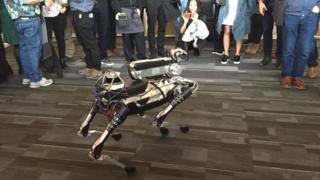
SpotMini went down well with the Ted crowd
Boston Dynamics founder Prof Marc Raibert came to the Ted (Technology, Entertainment and Design) conference with a new message about his military-funded robots – they could find ways in to homes and on to the streets.
He revealed a video of one of the company’s dog-like robots, SpotMini, delivering parcels to employees’ homes.
Its Atlas robot was also shown lifting and carrying packages.
And SpotMini later put on a show of cuteness to win over the Ted audience.
It demonstrated its ability to negotiate obstacles, walk forwards, backwards and sideways and hop on two legs, and, at the end of its demonstration, rolled over as if to have its stomach tickled.
Image copyright
Bret Hartman/Ted
On the Ted stage, SpotMini handed Prof Raibert a can of fizzy drink
Boston Dynamics has become synonymous with developing dexterous but terrifying robots, the skills of which are shown off via a series of YouTube videos.
Some have suggested the company’s image is at odds with that of parent company Alphabet – which owns Google – and there have been persistent rumours about it wanting to distance itself from its robotic wing.
Noel Sharkey, a robotics expert from Sheffield University, believes it needs a change of direction.
“They were mainly funded by the military in the past, but Google does not want that,” he said.
“Also, their big gog robot was too noisy for the military because of its petrol engine, and so they made an electric version that was not very good and the military cancelled their contract.”
But he remains a fan of the technology.
“Their Atlas robot is now quite incredible – it can open doors, which is impressive, believe it or not, and maintain a fixed goal even when interrupted,” he said.
“But their new robot, Handle, is just not like anything before it – stunning.”
At a previous conference, Prof Raibert described Handle as “nightmare-inducing”.
Image copyright
Boston Dynamics
Handle has been dubbed “Terminator on a hoverboard”
And it was later dubbed “Terminator on a hoverboard”.
This time, Prof Raibert appeared to want to show a more empathetic side to his robots.
Showing a video of Handle jumping on to a table, he told the Ted audience: “It likes to put on a show.”
And during SpotMini’s demonstration, he said: “It is a little bit of a show-off”.
Later, as SpotMini wandered among the Ted crowd, Prof Raibert was clearly pleased it was going down well.
“People like to pet it,” he said.
The YouTube videos received many “likes” as well as criticisms, Prof Raibert said, and Boston Dynamics was determined to find new ways to appeal to the public – showing robots slipping on banana peel, for instance.
He said the company’s experiments with robots delivering parcels were “70%” there but added it was harder for the robots to negotiate the small spaces in homes than the rough outside terrain they were more associated with.
Image copyright
Boston Dynamics
Boston Dynamics’ Atlas robot can negotiate difficult terrain
Boston Dynamics has a long history of viral videos showing off its robots. Some of its best known include:
- Big Dog, a quadruped robot designed for the US military with funding from Defense Advanced Research Projects Agency (Darpa)
- Petman (Protection Ensemble Test Mannequin) – a bipedal device constructed for testing chemical protection suits. It is the first anthropomorphic robot that moves dynamically like a real person. Much of its technology is derived from Big Dog
- Atlas (Agile Anthropomorphic Robot) a 6ft (183cm) bipedal robot, based on Boston Dynamics’ earlier Petman humanoid robot, and designed for a variety of search and rescue tasks. It is a high mobility, humanoid robot designed to negotiate outdoor, rough terrain
- Handle – a research robot on wheels that stands 6.5ft (198cm) tall, travels at 9mph (14.5km/h) and jumps 4ft (122cm) vertically. It uses electric power to operate both electric and hydraulic actuators, with a range of about 15 miles (24km) on one battery charge.
Ted 2017: Scary robots that want to be useful

